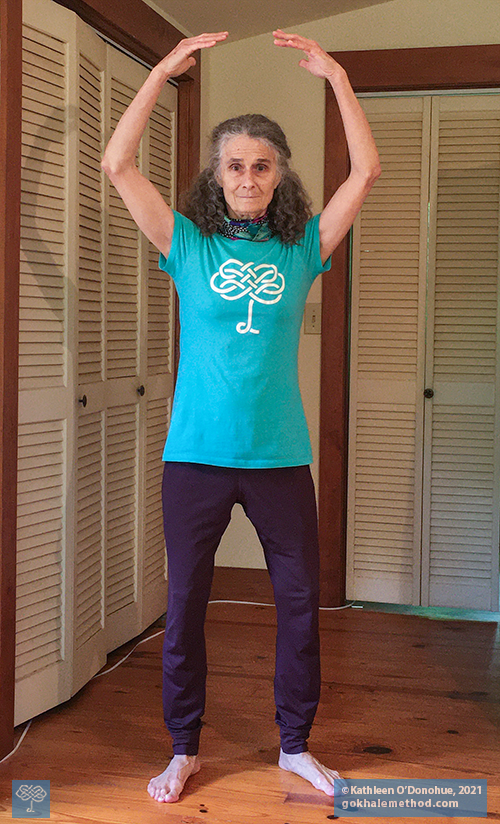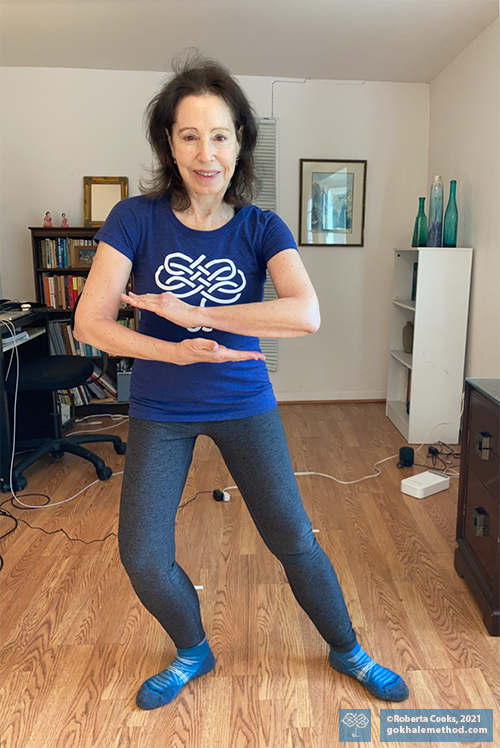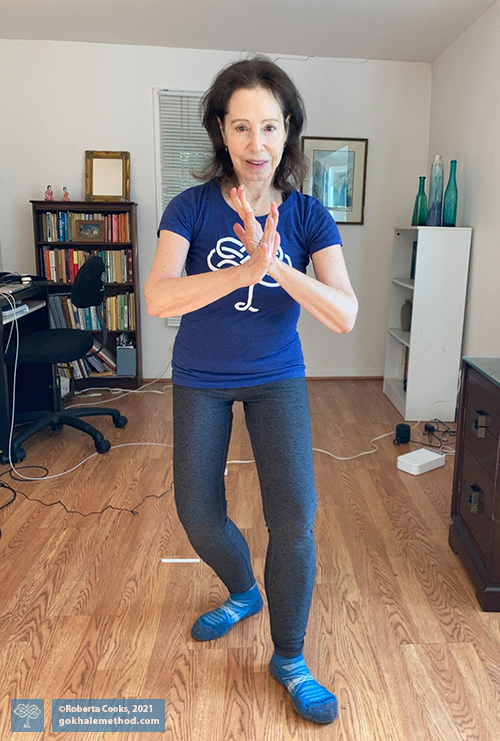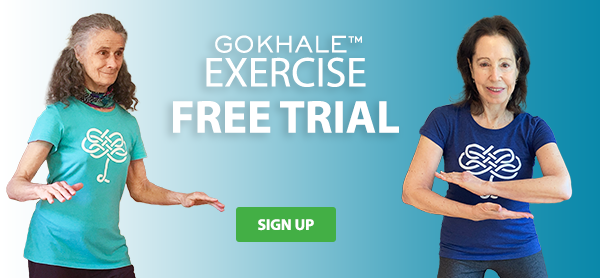Gokhale Moving Meditation
In this blog post Gokhale Method teacher Clare Chapman interviews Roberta Cooks and Kathleen O’Donohue to find out more about their Gokhale Moving Meditation classes. Roberta and Kathleen have been Gokhale Method teachers for 11 and 5 years respectively—and longtime practitioners of Tai Chi Chih (Roberta), and Tai Chi Qigong (Kathleen).*
*Please note that various traditions referred to in this newsletter use different spellings—so for example “Chi” can also be written “chi”, “ch’i”, “qi” or “Qi," depending on the tradition.

Kathleen keeps her ribs anchored
as she lifts her arms for “Painting Rainbows."
1. Tai Chi and Qigong are practices many people have heard of, but perhaps don’t know much about. Can you explain the practice?
Kathleen: Tai Chi and Qigong are centuries-old related mind body practices that originated in China, and can be translated as “life-energy cultivation." Both include postures and gentle movements to cultivate mental focus, breathing, and relaxation. Movements can be adapted for sitting, standing, and walking.
Roberta: Tai Chi Chih is a moving meditation practice that was developed by Justin Stone, a Tai Chi Chuan Master, who created a gentle practice that could be learned relatively easily by people of all ages and abilities. It is made up of 19 movements and a final pose. Each movement is repeated many times while focusing on relaxing the body, breathing, and feeling the flow. The goal of practice is to activate, balance, and circulate the chi, the life force that keeps us breathing, healthy, and vital.
2. How did you each come to your practice and to teaching it?
Kathleen: My Tai Chi and Qigong experience began in 1985 as a student of Professor Chi, Kwan Wen, a student of Chen Man-Ch’ing. In 1988, with the encouragement of Professor Chi, I became an instructor of Yang Style short and long form. In 2009, I became certified by the Tai Chi for Health Institute in Dr. Paul Lam's Tai Chi for Arthritis program. I have taught it and several other forms ever since.
Roberta: I was an Argentine Tango dancer for many years, which I found to be a very meditative dance. I also practiced many kinds of mindful meditation including Medical Qigong with Dr. Roger Jahnke and Wisdom Healing Qigong with Master Mingtong Gu. By chance, I found a Tai Chi Chih class at my local YMCA. I felt such joy and peacefulness without any of the effort of doing a sitting meditation practice. I continue to feel its physical, mental, emotional, and spiritual benefits in my own life. Teaching is always the deepest form of learning and shared practice in a group adds energy and depth for all involved.

Moving Meditation incorporates many Gokhale Method skills, such as using your inner corset, keeping your neck tall, and externally rotating your feet and legs.
Here Kathleen applies them in “Flying Dove Spreads its Wings."
3. What do the Moving Meditation classes bring to the Gokhale Exercise program?
Kathleen: Tai Chi and Qigong teach us gentle, flowing movements that enhance relaxation. They can be done sitting and standing, at a pace and duration of one’s choice and ability in the moment. It is a relaxing situation in which you can be talked through and shown another activity in which you can apply your Gokhale Method posture skills, gaining fresh awareness and openness.
Roberta: We offer a way to practice the Gokhale Method which focuses on learning how to relax increasingly deeply into movement. We teach a limited number of moves that we repeat many times. There is a special kind of learning that happens when you become more familiar with a movement and can then focus on its finer points. You also have a chance to repeat the class material and delve deeply into it with our class video recordings.
4. What do your classes have in common with the Gokhale Method teaching on posture?
Kathleen: Both of these teach healthy ways to move. Tai Chi Qigong teaches one to move with “beautiful upright posture." In my decades of being a student of Tai Chi Qigong, I’ve never been instructed to “tuck” my pelvis. Unfortunately, I’ve met students who have been taught this. I asked a Master Trainer directly about this and she stated that she does not teach tucking and believes it is a mistranslation.
Roberta: Although you can learn the 19 movements of Tai Chi Chih relatively quickly, they are subtle and must be practiced mindfully over and over to make them an effortless part of you. Learning the Gokhale Method is very similar. Students learn the elements of healthy posture in a short period of time, and then repetition integrates them into daily life.
5. How do the movements you teach help Gokhale Method students?
Kathleen: It’s a new way for students to cultivate their kinesthetic and proprioceptive skills—becoming more aware of their posture and position in space. They are likely to be freer from old habitual patterns as they are doing sometime new with their bodies. Students can experience stress and tension before and during their postural change journey. This helps them let go of that.
The healthy posture principles taught in the Gokhale Method are woven into each
Moving Meditation class, as Roberta shows in this video.
Roberta: The Moving Meditation is so compatible with what is taught in the Gokhale Method. For example, the grounding and flowing movements help students consolidate the principles of tallstanding and glidewalking. In my classes I weave in Gokhale posture principles throughout, reminding students how to use rib anchor, shoulder rolls, external rotation of the legs, and kidney bean feet, to make the movements flowing, relaxed, and comfortable.
6. Can you say something about the meditational component of your classes. Do you find it resonates with the Gokhale Method?
Kathleen: I find both to be mindfulness practices. Each allows me to be present in my body in each moment and to find deeper levels of relaxation and wellbeing. They are great opportunities to let go, release, and return to the present.

Roberta demonstrating “Pulling Taffy." This is part of a sequence where, as the lower body
moves from side to side, the stacked arms move apart as if pulling taffy (candy).
Mindfulness builds better coordination of these different movements.
Roberta: All moving meditation practices keep us in the present moment, mindfully focused on each part of our bodies moving through space. The Gokhale Method also takes us mindfully back into our bodies to relearn how to sit, stand, walk, bend, and sleep. I tell my students that the best way to integrate healthy posture into your life is to think of it as a mindfulness practice that you weave through your daily life for your physical health and total well-being.
7. In what ways has learning the Gokhale Method enhanced your Tai Chi Chih and Qigong practice?
Kathleen: The Gokhale Method enhanced my practice of Tai Chi and Qigong by adding excellent postural knowledge to apply to this activity that I love.
Roberta: The Gokhale Method has given me a solid foundation for moving. Many others who teach and practice Tai Chi Chih do not have this same healthy posture foundation and without my Gokhale training I might have integrated unhealthy movements into my practice. My Gokhale Method training helps me to teach my Tai Chi Chih students to move in a healthy way.
8. Do you find the Gokhale PostureTracker™ helps in Moving Meditation?
Kathleen: Yes, because the PostureTracker sensors and app monitor posture are ideal for use with slow moving activity. For example, the Upright and Relaxed setting can tell you if you are either swaying or rounding your spine. The Level Head setting gives real-time feedback that helps you keep your head well-balanced on a long neck rather than jutting forward.

Using the PostureTracker allows you to catch any poor posture habits as they happen,
correcting them using the Gokhale Method techniques.
Roberta: I love the idea of using the PostureTracker to check and improve my posture practice. The PostureTracker can be especially useful if I want to work out the best way to execute particular Tai Chi Chih movements. When I am actually doing the practice of Qigong I want to be absorbed in my body, totally relaxed and feeling the flow of energy. At that point I integrate what I have learned by using the PostureTracker in my pre-practice work.
9. Do you have a favorite Qigong movement or practice?
Kathleen teaching “Wave Hands in Clouds." As in the Gokhale Method, imagining specific actions can help bring particular qualities, such as lightness and smoothness, to your movement.
Kathleen: I generally don’t have favorites, but one movement brings especially fond memories of my original teacher, Professor Chi, Kwan Wen. He frequently did Wave Hands in Clouds while waiting, instead of just wasting time.

Roberta showing the crossed hand position in “Daughter on the Mountaintop."
Roberta: My favorite movements are always changing, based on changes in my practice, aha moments, and my mood and body sensations on a particular day. One I always love to do is Daughter on the Mountaintop. This is part of a forward and back movement sequence where hands and arms start low and then move to the top of the mountain, hands crossed with the left hand nearer the heart.
10. Is your program suitable for all levels and abilities?
Kathleen: Indeed! These slow, gentle movements can be done sitting or standing, modified to your range of motions and your choice of duration and number of repetitions. Come join us!
Roberta: Absolutely! Our movement meditation programs are meant to be practiced by people of all ages and abilities. They can be easily modified to fit with your physical comfort level. We devote time for student questions at the end of each session.
Gokhale Moving Meditation classes take place every Monday at 2PM (Pacific Time) with Roberta and every Wednesday at 12PM (Pacific Time) with Kathleen.
Please share below your questions or comments about Moving Meditation:


Comments
Travel Conference
Travel Conference
Add New Comment
Login to add commment
Login